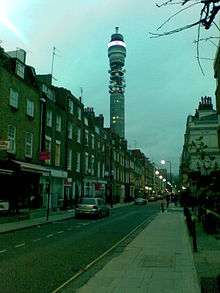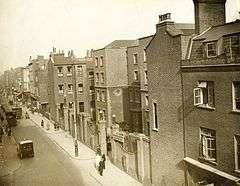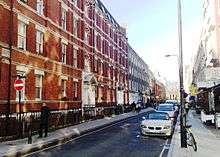Cleveland Street, London
Cleveland Street in central London runs north to south from Euston Road (A501) to the junction of Mortimer Street and Goodge Street. It lies within Fitzrovia, in the W1 post code area. Cleveland Street also runs along part of the border between Bloomsbury (ward) which is located in London Borough of Camden, and West End (ward) and Marylebone High Street (ward) in the City of Westminster.[1] In the 17th century, the way was known as the Green Lane, when the area was still rural, or Wrastling Lane, after a nearby amphitheatre for boxing and wrestling.[2]
 A view of Cleveland Street looking south from the intersection with Greenwell Street (previously Buckingham Street), featuring the BT Tower | |
| Length | 0.4 mi (0.6 km) |
|---|---|
| Postal code | W1 |
| Nearest Tube station | |
| Coordinates | 51.520867°N 0.139196°W |
| north end | Euston Road |
| south end | Goodge Street |
Geography
_being_laid_out_in_1774.jpg)


Cleveland Street marks the border between the City of Westminster to its west and the London Borough of Camden to the east. This border is ancient, largely following the old divide between the western parish of Saint Marylebone and the parish of Saint Pancras to the east and can be traced back as far as 1792.[4] The street was also a boundary between large estates, such as the Bedford Estate and the Berners Estate.[5] Maps show that the southern end of modern Cleveland Street, beyond Riding House Street, was known as Upper Newman Street and then Norfolk Street. The northern section was once known as Upper Cleveland Street and Buckingham Place.[6]
It became Cleveland Street for its full length after a renumbering was ordered by the Metropolitan Board of Works in 1867.[7]
The name comes from the Charles FitzRoy, 2nd Duke of Cleveland whose estate was connected in the 19th century with the Southampton (Wriothesley) property [8] via Henry Fitzroy, 1st Duke of Grafton. The Southampton property later became the Bedford Estate. Cleveland Street is renowned for several historical events and buildings, the most notable recent one being the BT Tower.
History
The Cleveland Street Scandal happened in 1889 at 19 Cleveland Street (now demolished) which at the time housed a male brothel in which teenage telegraph boys served as prostitutes.[9] The scandal was rumoured to involve Prince Albert Victor, Duke of Clarence and Avondale, an heir to the throne of Great Britain, though this allegation has never been substantiated.[10] A show inspired by the Cleveland Street scandal and titled Cleveland Street The Musical - with book and lyrics by Glenn Chandler - ran in London between April and May 2011.
In his book Jack the Ripper: The Final Solution, Stephen Knight mentions Cleveland Street in conjunction with two houses in the street. According to Knight's theory, the royal family was connected with the Jack The Ripper murders from 1888, via the same Prince Albert Victor who he claims met his later wife, Catholic prostitute Annie Elizabeth Crook, at the studio of the painter Walter Sickert at 15 Cleveland Street. After their secret wedding, Annie Elizabeth Crook was allegedly settled in a flat at 6 Cleveland Street.[11] The conspiracy theory behind the murders described in Knight's book has been loosely adapted into From Hell (1999), a graphic novel by Alan Moore from which a movie with the same title was adapted in 2001. Several scenes in the movie take place in Cleveland Street, although they were not shot on location.[12]
Notable buildings
The Grade II listed buildings are numbers:[13]
- 16-22 (terraced houses with attached shop, the first with later shop; c.1780-1800). No 22 (originally 10 Norfolk Street before the street's renumbering), was twice the home of Charles Dickens.[14]
- 54 was Cleveland Hall which was constructed as a radical meeting place as a bequest from William Devonshire Saull. Secularists, spiritualists and anarchists met there until the hall was converted into a mission hall for the West London Methodist Mission in 1890.
- 68 (terraced house with shop c.1780-1800)
- 106 (terraced house and shop 1832-5)
- 45-49 (block of flats dated 1911 with red brick with blue brick banding and stone dressings, tiled roof in the Arts and Crafts free style)
- 139,141 (terraced houses c.1790-1800)The latter has a blue plaque signifying that Samuel Morse, inventor of the Morse Code once lived there.
- 143-149 (terraced houses, some with shops c.1790-1800)
- 151 (George and Dragon corner public house c.1850 rebuild or recasting)[15]
- The BT Tower complex. The tower was London tallest building when it was completed in 1960 and it remains a major London landmark, being currently the 8th tallest building in London at 177 metres plus a 12-metre antenna.[16]
- The frontage building of the former Cleveland Street workhouse later Middlesex Hospital annexe and outpatient department on the eastern side of the street at 44 [17] c.1776. Over the years from 1778 until 2005 the building operated as a workhouse then a workhouse infirmary and more recently as a hospital. UCLH NHS Foundation Trust in 2010 proposed the building's demolition in a planning application (and conservation area consent) submitted to Camden London Borough Council to replace it with a large building mixing private accommodation with commercial space.[18][19] However adjoining Westminster City Council objected on three grounds on 2 December 2010.[20]
The Cleveland Street Workhouse[21] is of particular importance in light of the fact that Charles Dickens is known to have lived nearby in what is now 22 Cleveland Street. Dickens lived there as a young child between 1815–1816 and then again as a teenager between 1828-1831. His residence in the street has led to the suggestion that the nearby workhouse was probably the inspiration for Oliver Twist.[22]
Cleveland Street hosted the Middlesex Hospital, closed in 2005 and since demolished. The hospital occupied an entire block on the western side of the southern section of the street. The future of this site is currently uncertain, despite its sale by nationalised Icelandic Kaupthing Bank to Aviva Investors and Exemplar Properties.[23]
Cleveland Street was described as an area of special architectural and historic interest when it was designated a Conservation Area on 20 November 1990.[24] Anomalously on its Camden side Cleveland Street is part of two conservation areas: the Fitzroy Square conservation area,[25] and the Charlotte Street conservation area.[26] This double designation is rare and possibly unique.
See also
References
- "Welcome to Westminster.gov.uk". Westminster.gov.uk. 27 May 2014. Archived from the original on 28 March 2012. Retrieved 28 March 2016.
- "Marylebone and its Manors", Transactions of the London and Middlesex Archaeological Society, 4: 64, 1918
- Samuel Grimm Illustration dated 1701-2
- "Archived copy". Archived from the original on 20 February 2010. Retrieved 21 May 2010.CS1 maint: archived copy as title (link)
- Survey of London: volume 36: Covent Garden (1970), pp. 34-37
- Horwood Map Archived 20 February 2010 at the Wayback Machine(1792-1799), Peter Potter Map (1832), George Lucas Map of Maylebone (1846), Map of the Parish of St. Marylebone (1832) at Westminster City Archives
- "Minutes of Proceedings of the Metropolitan Board of Works - Metropolitan Board of Works (London, England)". Books.google.com.au. 1867. p. 980. Retrieved 28 March 2016.
- Survey of London: volume 21: The parish of St Pancras part 3: Tottenham Court Road & neighbourhood (1949), pp. 1-6
- Theo Aronson, Prince Eddy and the Homosexual Underworld (1994) pp. 8–10 and Montgomery Hyde, The Cleveland Street Scandal (1976), pp. 20–23
- Lees Milne, Harold Nicolson (1980-81), pp.231
- Stephhen Knight, Jack The Ripper: The Final Solution (1976), pp. 22–28
- Internet Movie Database, From Hell Locations
- National Heritage List - List Entry numbers 1356766, 1356767, 1356769, 1356771, 1219525, 1066258, 1291411, 1066259, 1219538 and 1242917
- "Plaque unveiled to identify Charles Dickens first London home". Fitzrovia News. 10 June 2013. Retrieved 28 March 2016.
- https://www.historicengland.org.uk/listing/the-list/list-entry/1219538
- "BT Tower, London". SkyscraperPage.com. Retrieved 28 March 2016.
- "Archived copy". Archived from the original on 11 January 2011. Retrieved 22 January 2011.CS1 maint: archived copy as title (link)
- Camden Council, Details Page for Planning Application - 2010/2205/P Archived 17 March 2012 at the Wayback Machine
- Camden Council, Details Page for Planning Application - 2010/2209/C Archived 17 March 2012 at the Wayback Machine
- Westminster City Council, Decision document
1. The City Council considers that the existing building is a heritage asset which makes a positive contribution to the character and appearance of the area. The proposed development would not preserve or enhance this character and appearance. The City Council considers that retention and refurbishment of all or a substantial part of the existing building should be pursued.
2. The proposals provide insufficient on-street car parking facilities for the development, particularly for the private housing market which would generate significant car parking demand. This would increase the pressure for car parking on surrounding streets to the detriment of highway safety and convenience.
3. The submitted Daylight, Sunlight and Shadow study shows that the proposed development would result in unacceptable losses of daylight for some of the residential properties on Cleveland Street which face the application site. This would be materially harmful to the local residential environment and lead to an unacceptable reduction in the quality of residential amenity. Retrieved 2011-07-26 - "The Cleveland Street Workhouse". The Cleveland Street Workhouse. Archived from the original on 18 February 2011. Retrieved 28 March 2016.
- Lorna Bradbury (20 January 2011) "Oliver Twist's Workhouse Discovered", The Telegraph
- Deirdre Hipwell (18 July 2010), "Aviva wins Noho Square scheme", Independent on Sunday
- "Department of Planning and City Development, Westminster City Council, Cleveland Street Conservation Area Audit" (PDF). 11 April 2006. Retrieved 14 December 2010.